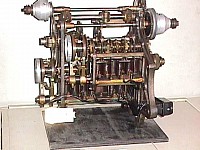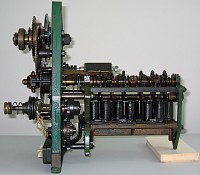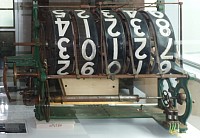Computer Science
Computing History Displays: Second Floor - Totalisators
We have a few items of machinery on display as summarised below. A lot more information on totalisators is available in the special set of pages devoted to the topic.
Pre-war Shaft AdderThis “adder” was part of a totalisator at the racecourse in Mentone, a suburb of Melbourne. The machine, made by Automatic Totalisators Limited in Sydney, was installed in the early 1930s after totalisators were legalized in Victoria. The machine was moved to Ipswitch near Brisbane in 1948 and finally dismantled in 1978. The totalisator comprised 50 of these adders, so could keep track of the total number of win and place bets on 24 horses and the grand totals. These adders have two shafts and could register ten bets simultaneously but up to 100 ticket machines could be operated using mechanical scanners. This adder was donated by Brian Conlon of Brisbane.
Post-war Shaft Adder
This “adder” was part of a totalisator at Awapuni Racecourse in Palmerston North and was donated by the Manawatu Racing Club. It was made and installed around 1946. This machine kept track of the totals of both win and place bets for 24 horses. As well as recording the totals on small counters attached to each adder the machine showed the expected dividends for each horse, making use of a “barometer” style display. By using “scanners” up to 96 machines ticket issuing machines could be used simultaneously This adder was for one of the grand totals. It is the same as the other adders except for a switch to signal every 10th bet for a numeric grand total display.
Mechanical Counter
This is one of the grand total counters from the totalisator at Awapuni in Palmerston North – donated by the Manawatu Racing Club. Although installed in 1946 the counter uses technology developed in the early 1920s.
This device does a very simple job of counting, by 10s, the total number of bets on a race. Its design is complicated by it having to be very large so that it could be seen from a distance. The counter is driven to count up by a slipping belt but may only count when released by the escapement to the lower right. Bets are stored in a spring in a “buffer” at lower left to give the massive display wheels time to speed-up. The carry advance mechanism for the large wheels is worthy of note.






